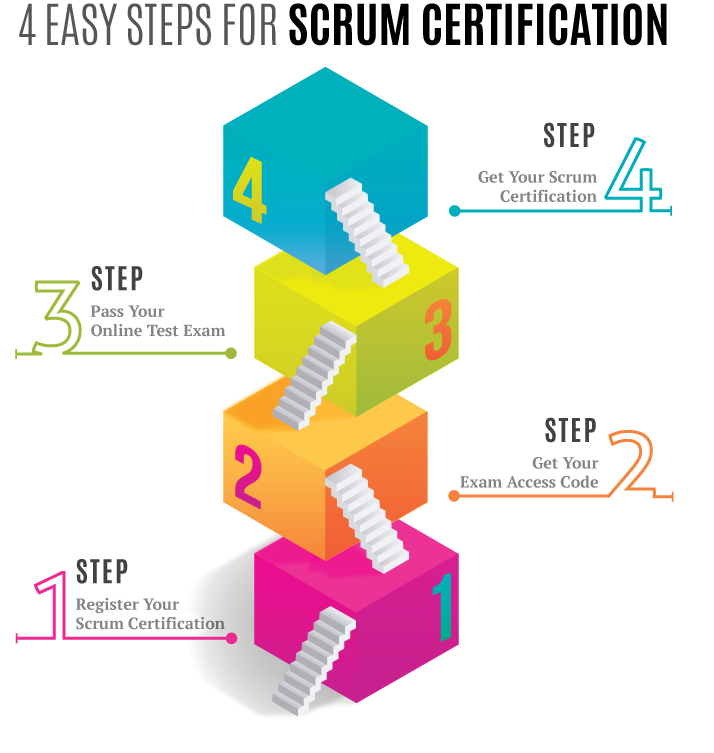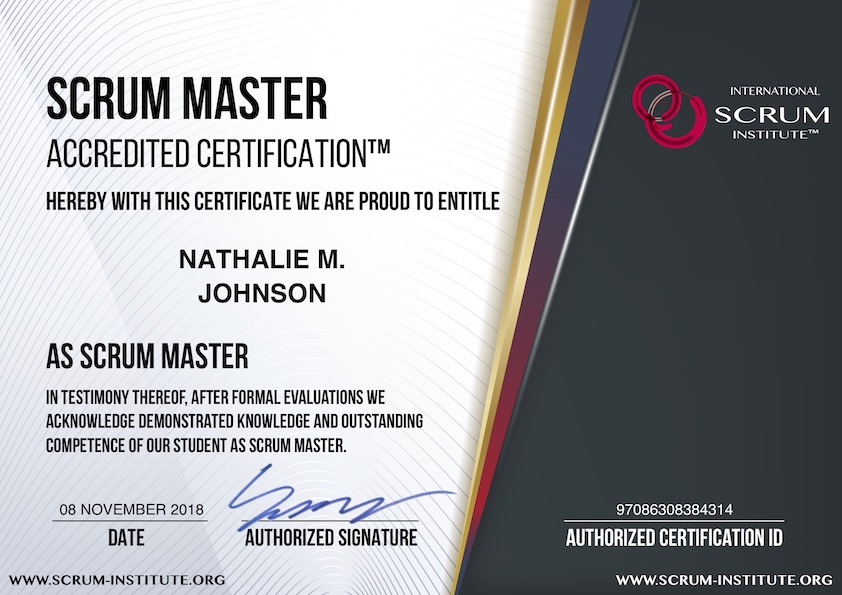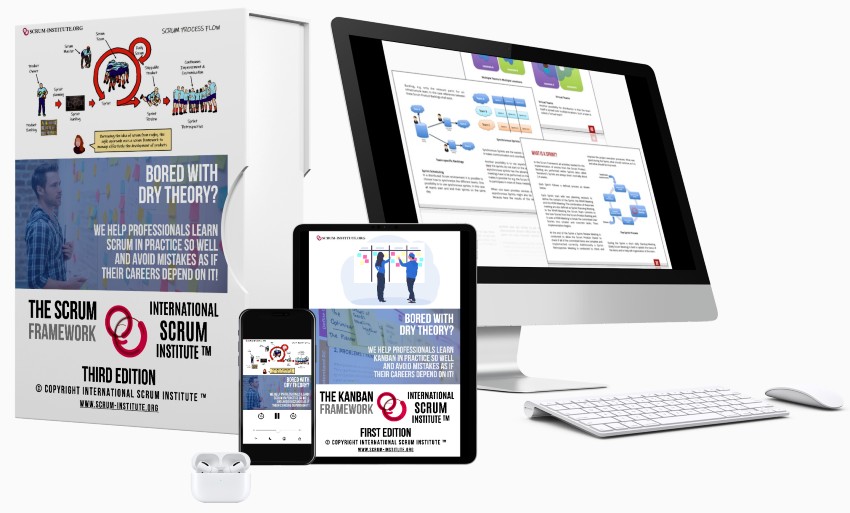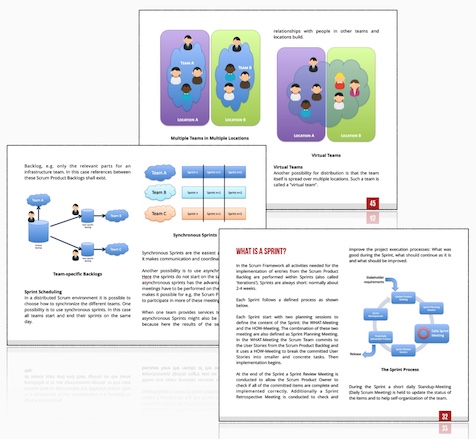Scrum Sprint Planning Meeting
The WHAT-Meeting & The HOW-Meeting
A Scrum Sprint Planning Meeting is a collaborative and iterative gathering within the framework of Scrum, a popular agile methodology for project management. This meeting serves as a pivotal event where the team members converge to collectively plan and organize upcoming tasks and objectives.In this dynamic session, the team sets the course for the upcoming sprint, a predetermined time-boxed period during which a set of prioritized work items, known as the backlog, are completed. The mind of each team member becomes a focal point during the Scrum Sprint Planning Meeting, as their insights, expertise, and perspectives contribute to crafting a comprehensive plan that aligns with the project's goals and timelines.
Within the context of Scrum, the term "mind" emphasizes the cognitive collaboration that takes place during the planning meeting. It encapsulates the collective intelligence and problem-solving abilities of the team members as they synchronize their thoughts to devise an effective strategy. The meeting encourages an open exchange of ideas, ensuring that the collective mind of the team is harnessed to identify potential challenges, allocate resources judiciously, and formulate a roadmap for success. The Scrum Sprint Planning Meeting is a manifestation of the agile principle that values individuals and interactions, underscoring the significance of a synchronized team mind to foster adaptability and responsiveness in the face of evolving project requirements.
The WHAT-Meeting
A WHAT-meeting, in the context of agile development methodologies like Scrum, is a pivotal event where the minds of the scrum team converge to discuss and determine the "WHAT" of their upcoming sprint commitment. This gathering involves many team members collaboratively engaging in discussions, sharing insights, and collectively deciding on the prioritized tasks that will constitute the sprint backlog. The WHAT-meeting often employs techniques such as planning poker to estimate the effort required for each task, fostering a shared understanding among team members and ensuring alignment towards a common sprint goal. This event plays a crucial role in shaping the direction of the upcoming sprint, emphasizing transparency, collaboration, and a collective mindset within the scrum team.
Each Sprint and each Sprint Planning Meeting starts with a WHAT-Meeting. Goal of this session is to define a realistic Sprint Backlog containing all items that could be fully implemented until the end of the Sprint.
In the dynamic realm of project management, the WHAT-meeting serves as a pivotal framework for teams seeking clarity and direction. This gathering provides a structured way for people to synchronize their efforts and align their goals. For example, in a Kanban system, the WHAT-meeting becomes an essential checkpoint where teams collaboratively examine their progress and adjust their priorities. The velocity of work is carefully scrutinized, ensuring that the team is moving at an optimal pace, and questions are encouraged to be raised and addressed openly.
During the WHAT-meeting, a considerable amount of time is dedicated to examining the iteration progress. Teams engage in a detailed review, akin to a sprint review in agile methodologies (See also Sprint Review Meeting: Goals and Protips), assessing the completed tasks and evaluating the overall performance. This iterative approach allows teams to make necessary adjustments and enhance their workflow continually. The WHAT-meeting goes beyond a mere list of tasks; it delves into the collective mindset of the team, fostering an environment where creativity and collaboration flourish. In this way, the meeting becomes a spring commitment, a promise to iterate and evolve, embodying the essence of agility in project management.
The WHAT-Meeting Preparation
For a successful WHAT-Meeting some preparation is necessary:
- The Scrum Product Owner defines the Sprint Goal.
- Based on this goal the relevant entries in the Scrum Product Backlog are chosen by the Scrum Product Owner.
- These entries are updated and broken into smaller stories so that they can be completed within one Sprint.
- The entries are estimated & prioritized.
- The team defines their capacity for the upcoming Sprint.
Sprint Goal
The Scrum Product Owner defines the Sprint Goal. It is a short description of what the sprint will attempt to achieve and what should be realistic and comprehensible for everyone.
Team Capacity
The total capacity of the Scrum Team might change from Sprint to Sprint. In order to come to realistic commitments it is necessary to know the total capacity of the team for the upcoming Sprint considering e.g. vacations, public holidays, efforts for Scrum Meetings and time needed for other activities during the Sprint.
 Sprint Planning Meeting, What Meeting
Sprint Planning Meeting, What Meeting
The WHAT-Meeting Session
During the session the Scrum Product Owner presents the Sprint Goal and discusses it with the team. After that the Scrum Team iterates through the relevant items in the Scrum Product Backlog and the team commits to the entries which they think can be fully completed within the Sprint. The decision should be based on available capacity and knowledge about the entries.
At the end of the session the list of all committed entries from the Scrum Product Backlog provides the base for the HOW-Meeting and the Scrum Backlog.
The HOW-Meeting
A "HOW-meeting" is an integral event in the agile development methodology, particularly within the Scrum framework. This meeting serves as a platform for the scrum team to collectively align their minds and strategies towards achieving their sprint commitment. The term "HOW" itself encapsulates the essence of the meeting, emphasizing the need to delve into the intricate details of the upcoming sprint and collaboratively determine the most effective ways to accomplish the set goals.
During the HOW-meeting, the scrum team engages in open discussions, drawing upon the diverse perspectives of its many members. This inclusivity fosters a dynamic exchange of ideas, allowing the team to tap into the collective intelligence and experience of each member. Planning poker, a popular technique in agile methodologies, is often employed during these sessions to estimate the effort required for different tasks. This ensures that the team reaches a shared understanding of the workload and establishes a solid foundation for planning the upcoming sprint. Ultimately, the HOW-meeting serves as a crucial milestone in the Scrum framework, fostering collaboration, aligning minds, and enhancing the team's collective commitment to a successful sprint.
The goal of the How-Meeting is to fill the Sprint Backlog by identifying the concrete tasks needed for complete implementation of the Scrum Product Backlog entries. Tasks normally include design-, implementation-, test- and documentation-activities.
The HOW-Meeting can be done in a separate session after the WHAT-Meeting, during the WHAT-Meeting when committing the entries or both.
After identifying the necessary activities they are estimated by the team. Base for this estimation (See more abour Scrum Planning Poker) should be person-hours. The team should how long it will need to do everything that is required to finish this activity.
 Sprint Planning Meeting, How Meeting
Sprint Planning Meeting, How Meeting
A Comprehensive Guide to Sprint Planning Meetings in Agile Project Management
Sprint planning meetings, nestled deep within the realm of Agile project management, are the stepping stones for building a successful sprint. These time-boxed gatherings, often lasting up to 8 hours for a one-month sprint, are where the blueprint for upcoming work is crafted meticulously. Contrary to what some might believe, it's not only about setting an agenda or objectives; preparation involves prioritizing tasks, estimating workload, and defining roles - akin to a well-rehearsed orchestra warming up before a performance. Expect the unexpected - outcomes can vary dramatically, aiming always for improvement not perfection. Let's start by diving into the nuts and bolts of these meetings.
To optimize your sprint planning meeting, ensure that the product owner clearly defines the sprint goal, while the development team collaboratively plans and commits to the work needed to achieve that goal. Additionally, keep the meeting timeboxed, focus on valuable outcomes, and allow for open discussions and adjustments to create a motivated and successful environment for your team. Remember, preparation is key; ensure that the product backlog is up-to-date and refined beforehand.
The Nuts and Bolts of Sprint Planning Meetings
Sprint planning meetings are like laying the tracks for a high-speed train journey, where every detail counts. It's during these meetings that the work for the upcoming sprint is carefully crafted and outlined. The key stakeholders—the product owner, Scrum Master, and development team—gather to sort out what needs to be done and how to get it done efficiently. These gatherings are often time-boxed, ensuring they don't stretch on too long—typically lasting up to 8 hours for a one-month sprint.
A key aspect of sprint planning meetings is to strike a balance between defining what can be delivered while also understanding how that work will be achieved, thus establishing realistic and achievable objectives. This requires a negotiation between value (what's most important) and effort (the time and resources needed). This is where the collaboration between the product owner, Scrum Master, and development team truly shines through.
For instance, if the product owner insists on adding a large number of features to the sprint backlog, but the development team believes it's too much to deliver in one sprint, negotiations will ensue. The product owner might prioritize or de-prioritize certain features based on input from the development team.
To ensure that everything runs smoothly during a sprint planning meeting, it's crucial that everyone comes prepared with updated information. The product backlog should be refined and up-to-date. Good preparation by the product owner ensures that goals are clearly outlined in the sprint backlog. Additionally, it's common practice for a backlog refinement meeting to occur before the planning session, further streamlining the process.
The dynamism and interplay between different roles in a sprint planning meeting play a crucial role in setting the stage for a successful sprint. Let's delve deeper into the distribution of roles within these meetings and their impact on decision-making processes.
The successful execution of any project hinges on clear objectives and seamless planning. Now let's explore the meticulous process of setting objectives and preparing for agile project management.
Setting Objectives and Planning Preparation
Creating clear and achievable objectives is the pivotal first step in ensuring a successful sprint planning meeting. Similar to preparing for a long journey, having a roadmap is essential to guide the team toward its destination. The product owner assumes a critical role in this phase by describing the sprint goal, serving as the North Star that guides the team's planning efforts.
To establish effective objectives, the product owner must closely collaborate with the development team to define and understand the goal. This partnership fosters a shared purpose, aligning both parties on the desired outcomes and cultivating a greater sense of ownership and accountability among team members. By engaging in open discussions and leveraging collective insights, the team can craft objectives that reflect both feasibility and value.
Importance of Detailed Objectives
Well-defined meeting objectives not only channel collective efforts but also serve as a yardstick for measuring progress. Vague or ambiguous objectives can lead to confusion, inefficiency, and lack of focus during the sprint. Conversely, well-defined objectives act as beacons, illuminating the path forward and empowering team members to make informed decisions that align with the overarching goal.
Furthermore, setting precise meeting objectives lays the groundwork for effective time management. So by clearly articulating what needs to be achieved, participants can allocate their time more efficiently throughout the meeting, avoiding unnecessary tangents or prolonged discussions on peripheral topics.
Aligning Objectives with Stakeholder Expectations
It's equally important to consider the perspectives of stakeholders beyond the immediate development team. The goals set during sprint planning should resonate with stakeholders' expectations for product increments and reflect market demands. This ensures that sprint efforts are aligned with broader business objectives and customer needs, ultimately enhancing product value and market competitiveness.
For instance, if a software development team is working on an e-commerce platform, stakeholder expectations may revolve around enhancing user experience, improving security measures, or streamlining payment processes. Therefore, setting meeting objectives that reflect these priorities fosters alignment between development efforts and business imperatives.
Here's how thorough preparation enhances the effectiveness of sprint planning deliberations.
Prioritization and Task Estimation in Backlog
In Agile project management, prioritizing and estimating tasks directly impact the success of sprint planning meetings. This process ensures that the most important tasks are accomplished first and provides a clear understanding of the effort required for each item in the product backlog. Let's break down this crucial process and explore how it contributes to successful sprint planning.
Prioritization
Before delving into task estimation, appropriately prioritizing the product backlog items is essential. This involves assigning a priority scale to each item, typically ranging from 1 to 10, with 1 being the highest priority and 10 being the lowest. Effective prioritization enables the development team to focus on delivering high-value features early in the sprint, maximizing the return on investment.
Consider a scenario where multiple user stories fill the product backlog. By assigning priority levels to these stories, the team ensures that critical user functionality or key technical tasks are addressed first. This approach aligns with Agile principles by emphasizing customer value and promoting an incremental delivery approach.
Task Estimation
Following prioritization, it's time to estimate the effort required for each item in the product backlog. The development team often uses story points as a relative measure to estimate work rather than traditional time units. Story points allow teams to compare and approximate complexity, uncertainty, and risk rather than focusing solely on hours or days required for completion.
For instance, when a development team is tasked with implementing a new feature in a sprint, instead of estimating that it will take 30 hours, they assign it a story point value based on relative complexity, uncertainty, and risk associated with the task. This approach facilitates a more accurate assessment of capacity for upcoming sprints and encourages a focus on valuable outcomes rather than getting bogged down in specific tasks or work details.
While traditional time-based estimates may seem precise, they often overlook critical factors like complexity and uncertainty, leading to inaccurate estimations. Story points offer a more holistic view of required effort and promote open discussion during sprint planning sessions.
By effectively prioritizing product backlog items and utilizing story points for task estimation, Agile teams can ensure that sprint planning meetings are grounded in valuable outcomes and realistic capacity assessments. These practices lay the groundwork for successful sprint execution and drive continuous improvement within Agile project management methodologies.
Now let's delve into the crucial roles that contribute to efficient sprint planning, ensuring that all aspects are meticulously addressed for successful sprint execution.
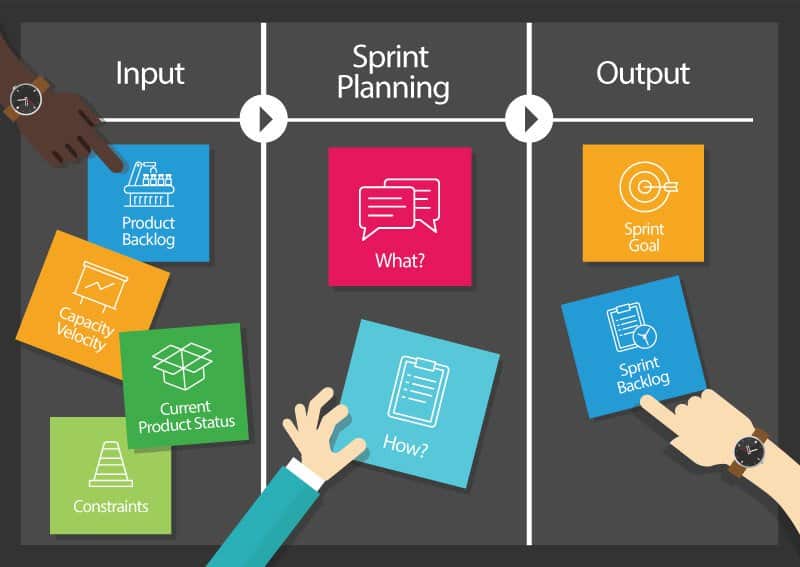 Sprint Planning Meeting
Sprint Planning Meeting
Role Definition for Efficient Sprint Planning
Effective sprint planning meetings in Agile project management demand well-defined roles and responsibilities. Let's delve deeper into the common roles and their specific duties during the sprint planning phase to ensure a clear understanding and smooth operation.
Common Roles and Responsibilities
In a typical sprint planning meeting, several key players contribute to shaping the overall plan and direction. The most common participants include the Product Owner, Scrum Master, and the Scrum Team (Development Team). However, there might be additional stakeholders involved, depending on the project's scale and complexity.
- Product Owner: The product owner plays a central role in sprint planning by describing the sprint objective or goal based on business priorities. They are responsible for ensuring that the product backlog is refined and ready for discussion during the planning session. Furthermore, they act as the primary bridge between the development team and stakeholders to convey project vision and ensure that everyone is aligned with the overarching goal.
- Scrum Master: While the Scrum Master might not actively participate in the planning process, their presence is crucial in facilitating a smooth collaboration between the product owner and the development team. They maintain an environment conducive to effective communication and decision-making during the planning session. Additionally, they aim to create a positive atmosphere that enables the team members to contribute freely without any impediments or distractions.
- Development Team: The development team is at the heart of sprint planning, collaborating with both the product owner and Scrum Master to plan and estimate the work necessary to achieve the sprint goal. They also commit to completing the work selected for the sprint by assessing its effort and feasibility. Moreover, they leverage their expertise to provide valuable input on how to effectively execute the tasks identified in the product backlog.
Having clearly defined roles ensures that everyone knows what is expected of them during sprint planning, fostering a sense of accountability among team members while streamlining communication channels.
For instance, imagine a car engine - every part has its unique function and needs to work seamlessly with other components for optimal performance. Similarly, each participant in sprint planning has a vital role to play, contributing towards achieving a successful outcome.
Clarity in roles allows for better coordination among team members, leading to a more efficient and productive sprint planning meeting where everyone understands their part in bringing about a successful sprint outcome.
Strategizing Workload and Sprint Duration
When planning out a sprint, two key components come into play: the capacity of the team and the duration of the sprint. Let's closely examine these essential elements and their impact on sprint success.
Capacity Determination
The capacity of the development team is critical in sprint planning. It's not solely about working hours; factors like holidays, planned absences, or other events affecting availability must be considered. Each team member's unique strengths and skills are equally important for effective task allocation.
For instance, if a developer has a planned vacation during an upcoming sprint, their reduced availability may require redistributing tasks to other team members. By anticipating such situations during capacity determination, workload balance can be achieved.
Capacity Planning Tip: Monitoring previous sprint performance and analyzing individual workload distribution provides valuable insights into actual team capacity.
Duration Decision
Once the team has assessed their capacity, the next step is deciding on the sprint duration. While sprints commonly range between 1-4 weeks, choosing the optimal duration requires thoughtful consideration.
Shorter sprints provide increased adaptability, swifter feedback loops, and greater focus on immediate priorities. They promote urgency and maintain productivity levels high as deadlines become more imminent.
On the other hand, longer sprints might facilitate in-depth analysis, complex problem-solving, and comprehensive testing. Striking a balance between thoroughness and efficiency is crucial to prevent sluggish progress or delayed deliverables.
Suppose your team is working on a significant new feature that requires thorough user testing and feedback integration. Opting for a slightly longer sprint could facilitate an iterative approach with multiple testing cycles and refinement stages before final implementation.
Duration Decision Insights: Observing past sprint performances and retrospective analysis can yield valuable insights into the ideal sprint duration for your team.
Considering both capacity determination and sprint duration decision is pivotal in structuring an effective plan for agile project management endeavors. These strategic choices form the groundwork for successful sprint planning by aligning team capacity with well-defined time boundaries for delivering valuable increments.
Discerning Outcomes and Results of Sprint Planning
Sprint planning meetings are vital for laying the foundation for a successful sprint. One of the key outcomes of these meetings is establishing a clear sprint goal. The sprint goal sets the direction for the team's work during the sprint, aligning their efforts towards achieving a common purpose. This creates unity and clarity, enhancing team morale and motivation.
The significance of having a well-defined sprint goal lies in its ability to provide focus. It helps prevent distractions or scope creep during the sprint, ensuring that everyone is aware of what they are working towards. The sprint goal acts as a guiding light, steering the team through uncertainties and changes that may arise throughout the sprint, generating a shared vision among team members.
In addition to defining the goal, sprint planning also involves creating a committed sprint backlog. The committed sprint backlog represents a realistic plan that outlines the work the development team believes they can accomplish during the upcoming sprint. This commitment is integral to maintaining accountability and fostering trust within the team.
The committed sprint backlog necessitates a thorough understanding of the work required to achieve the sprint goal. It involves careful estimation and consideration of individual and collective capabilities within the team. This process isn't about overburdening the team with excessive tasks but rather cultivating a collaborative environment where every member feels confident in their capacity to contribute meaningfully towards achieving the shared objective.
Understanding these outcomes of sprint planning empowers teams to approach these meetings with intentionality and purpose. By emphasizing clear goals and committed backlogs, teams can drive efficiency, teamwork, and productivity within each sprint, ultimately contributing to overall project success.Mastering these key aspects of sprint planning serves as an essential pillar for consistent project success, fostering a culture of collaboration, clarity, and achievement within agile teams.
Share It With Your Colleagues and Friends to Help Them Learn:
Scrum Sprint Planning Meeting - WHAT-Meeting & HOW-Meeting
|
|

|

|

|

|
|
 SCRUM INSTITUTE™
SCRUM INSTITUTE™



